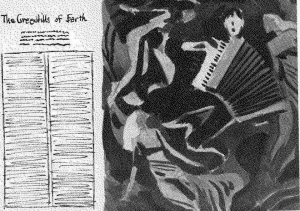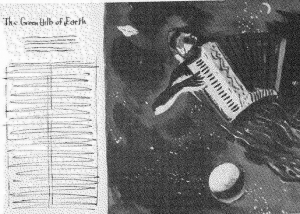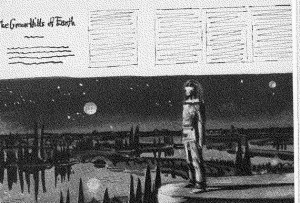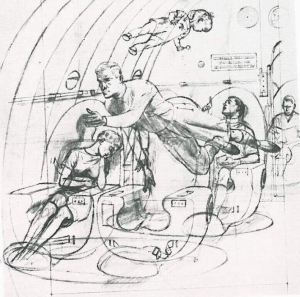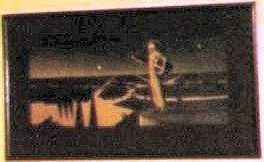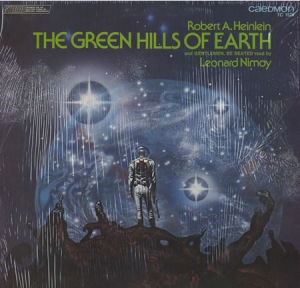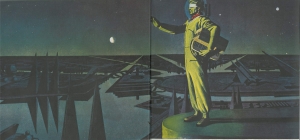 Fred Ludekens (1900-1982)
Fred Ludekens (1900-1982)
The Green Hills of Earth, 1947
Story illustration for Robert A. Heinlein’s “The Green Hills of Earth,” in The Saturday Evening Post (February 8, 1947)
Oil on canvas
Heinlein Society, © Virginia Heinlein
Author Robert A. Heinlein was delighted to have sold a science fiction short story to The Saturday Evening Post in 1947. In a January 15, 1947 letter to William J. Holt, who wrote the “Inside Information” column at the Post, Heinlein conveyed that he had been “plugging away for years” to sell something to that “top magazine market.”* The story, “The Green Hills of Earth,” was published a few weeks later and three more Heinlein stories were published by the Post in the following months.**
Fans of Heinlein’s science fiction will know this story about “Noisy” Rhysling, “. . . a jetman, second class, with eyes as good as yours, when he signed on for a loop trip to the Jovian asteroids in the R. S. Goshawk.”*** Rhysling was a character of amazing adaptability. Actor Leonard Nimoy recorded an album reading the story in 1977. The liner notes written by Heinlein reveal that the author in part based Rhysling on a blind machinist, Tony, he’d worked with during World War II. According to Heinlein, Tony had a perfect safety record, could identify his co-workers by the sound of their footsteps, and sometimes played an accordion and sang for them. ****
At the time the story was published, illustrator Fred Ludekens was given the challenge of creating an illustration about it for the magazine. Coincidentally Ashley Halsey, Jr., an associate editor for The Post, was gathering interesting stories of how various illustrators worked on some of their Post assignments, that were later published in a book, Illustrating for The Saturday Evening Post. The first three of five pages of that text on Ludekens focused on his process for creating The Green Hills illustration.
Artist Fred Ludekens found himself up against a situation that was literally “out of this world,” . . . . The story, . . . , involved some highly imaginary interplanetary flights. To have followed the usual procedure, Ludekens would have had to rocket off to Mars for a look-see there. . . . For a man who took his work seriously, the artist felt that he needed a lot less gravity.
‘In fact it wasn’t until I got my imagination into what the story calls ‘free flight’ that I was able to make a satisfactory approach to the illustration,’ *****
Some of Ludekens sketch ideas were reproduced in black and white in Halsey’s book. It is clear which was chosen for the illustration (seen above).
Ludekens even sketched out the idea of free-fall to get into the idea of the image better. Notice that the floating man in the foreground has a pipe in his mouth, and in the middle set of seats a father shakes his finger at his son floating in free-fall above him.
Heinlein’s story is spun around the radiation-blinded space engineer whose poetic skills equal Heinlein’s hero the English short-story author and poet, Rudyard Kipling. The title of the story refers to one of the songs the protagonist engineer added to and changed over the course of his galactic wanders.
The Green Hills of Earth grew through twenty years. The earliest form we know about was composed before Rhysling was blinded, during a drinking bout with some of the indentured men on Venus. The verses were concerned mostly with the things the labor clients intended to back on Earth if and when they managed to pay their bounties and thereby be allowed to go home. Some of the stanzas were vulgar, some were not, but the chorus was recognizably that of Green Hills.
The final rendition of Rhysling’s song was ‘recorded’ as the engineer’s last record for the log. The words Rhysling sang are interspersed with the factual description of his last moments, ending with the final chorus,
We pray for one last landing On the globe that gave us birth ; Let us rest our eyes on the fleecy skies And the cool, green hills of Earth.In Ludeken’s story illustration Rhysling was painted in phosphorescent tones against a dark futuristic landscape with a moon, earth, and stars hanging in the sky. The color clearly references the engineer’s death from radiation poisoning. Rhysling is pictured standing overlooking the vast landscape, his eyes covered with a bandage and his head in a glass bubble helmet. His left arm wraps around a large accordion. Ludekens clearly imagined Heinlein’s description of the instrument as a big mid-20th century squeezebox. But I would like to suggest that it would have been more likely that a futuristic space-traveling engineer and poet would have carried an old-fashioned smaller version of the instrument without all the buttons and keys merely in an attempt to save precious space.
That didn’t seem to bother Heinlein. After the article was published the painting ended up in the possession of the author. Today the painting is the property of the Heinlein Society. You can see in the image below, Ludekens seems to have extended the phosphorescent tone of paint into the water’s reflection and onto the night’s sky in the original painting. It just goes to show that what you see in a publication may not be exactly as the artist intended.
* I stumbled across a description of this letter with quotes on abebooks.com where this letter is sale. Abebooks.com is a huge consortium of rare and used book dealers world-wide. See, https://www.abebooks.com/servlet/SearchResults?an=Heinlein&kn=The+Saturday+Evening+Post&sts=t TYPED LETTER SIGNED. 3 pages, dated 15 January 1947, to William J. Holt, “Inside Information” Office, The Saturday Evening Post, signed “Robert A. Heinlein.”
** “Space Jockey” April 26, 1947; “It’s Great to Be Back” July 26, 1947; and “The Black Pits of Luna” January 10, 1948.
*** Robert A. Heinlein, “The Green Hills of Earth,” The Saturday Evening Post (February 8, 1947): 33.
****Leonard Nimoy, The Green Hills of Earth (New York: Caedmon Records, 1977), album cover illustration by Frank Kelly Freas (see below).
***** Ashley Halsey, Jr., Illustrating for The Saturday Evening Post (New York: American Book—Knickerbocker Press, Inc., 1951): 75.
June 27, 2013
By Joyce K. Schiller, Curator, Rockwell Center for American Visual Studies, Norman Rockwell Museum


